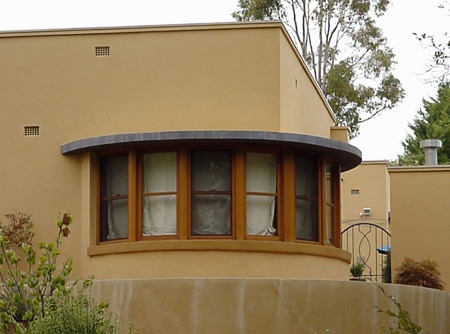Ken Oliphant

Window detail at 24 Arthur Circle, Forrest
Kenneth Oliphant (1896-1975) is recognised locally as an important architect in the development of private residential architecture in Canberra, particularly the inner south. He was the first privately practising architect in Canberra and specialised in domestic work. Many of his early designs were in the Forrest and Red Hill area in a variety of traditional styles, including Mediterranean and tudor. He also designed a small number of houses in the inter-war functionalist style.
Early career
Oliphant was born in Bendigo, Victoria and served with the 1st Field Co. Engineers in France in the 1914-18 War. Upon his return to Australia he was articled to the Melbourne architectural firm of Oakley and Parkes. In 1926 at the age of 30 he was posted to Canberra by the firm to supervise the construction of the first 26 houses that are in what is now known as the Forrest Urban Conservation Area. Oakley and Parkes won a nationally advertised competition to design the houses, for senior public servants and their families being transferred from Melbourne to the new capital.
Incidentally, after the Canberra work, the firm of Oakley and Parkes continued to practice for over thirty years. They designed a number of important modernist buildings in Melbourne, including Yule House (1932, 309-311 Little Collins Street), possibly the first Australian example of a moderne-style commercial building; and the moderne, curtain-walled Kodak House (1934-35, 252 Collins Street), the first Melbourne commercial building to use polished stainless steel in its facade.
Private commissions
Oliphant contributed to the final designs for some of the firm’s early private commissions in 1925-26 and began to design houses himself while he was still with Oakley and Parkes. The first was Calthorpe’s House (1927). Calthorpe and Woodger were Canberra’s first real estate agents and the house is now a museum, preserved in its original condition. He then branched out on his own, establishing the practice that was to continue in Canberra until his retirement in the late 1960s. His first office was in the Hotel Canberra and then above the Commonwealth Bank premises in Civic. The first house he designed independently was at 29 Mugga Way, Red Hill (1927-28) for the Head of Hansard, George Romans.
Oliphant designed a small number of inter-war functionalist style houses during the 1930s. Besides 24 Arthur Circle, Forrest, there were houses at 13 Evans Crescent, Griffith (now modified beyond recognition), the corner of Evans Crescent and Hann Street, Griffith (demolished in 1981) and in Dampier Crescent, Forrest.
Works
- Calthorpe’s House, 24 Mugga Way, Red Hill (1927)
- 29 Mugga Way, Red Hill (1927-28)
- Brackenreg, 18 Monaro Crescent, Red Hill (1928)
- The Alcorn House, National Circuit and Sorrell St, Forrest (1928)
- The Fraser House, Bougainville and Furneaux St, Manuka (late 1920s)
- The Dial House, 2 Moresby Street, Red Hill (early 1930s)
- 24 Arthur Circle, Forrest (1939)
- 70 Schlich Street, Yarralumla (1954)
Source
- Verona Burgess, The Capital’s First Private Architect, Canberra Times, 23 April 1995
- Peter Freeman (ed), The Early Canberra House, Canberra, 1996
- Philip Goad, Melbourne Architecture, Sydney, 1999